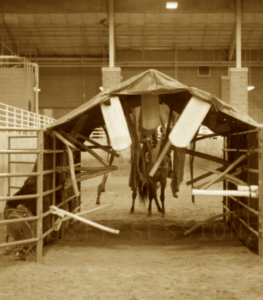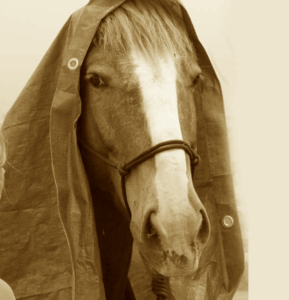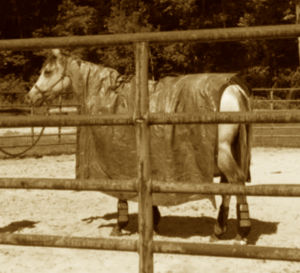Editor’s Note: Daniel Dauphin is a Best Horse Practices Summit presenter, an expert on bits and bitting, and a popular clinician. He also has a podcast, Adult Onset Horsemanship.
By Daniel Dauphin
Read Learned Helplessness and Flooding, Part I
Not long ago, I saw a video of a young colt starter with a line of colts tied up. Behind them, big black trash bags on sticks billowed and flapped in the wind. He was proudly showing off how broke his colts were going to be. This practice should not be Plan A.
 This is flooding.
This is flooding.
Flooding is putting the horse in the presence of a stimulus for an amount of time and with an intensity unrelated to the horse and its responses. For example, “I’m going to tie you up here, with all of this going on, for three or four hours. Good luck! Get less scared like a good boy!”
Flooding, as felt and judged by the animal or person effected, is how you push through to the extreme of Learned Helplessness. Learned helplessness requires uncaring, unresponsive, and unrelenting stimulation, and the results are catastrophic and often irreparable. This is why flooding should be recognized. Continuous assessment and reading
of the animal throughout training cannot be overemphasized.
A far more successful and far less potentially traumatic method to tackle scary things would be Advance and Retreat, or what we commonly call desensitizing. The principle behind advance and retreat is that we are reading the horse and coupling its experience with the stimulus intentionally, and with awareness and empathy, in order to teach more
effectively and not push the horse to a mental state in which it is not capable of conscious choice or true learning.
 Flooding and desensitization are not at all the same; one requires and benefits from a person’s skills and takes the horse’s responses into account to allow for conscious choice and acceptance. The other is blech. That’s the behaviorists’ term. I don’t make the rules.
Flooding and desensitization are not at all the same; one requires and benefits from a person’s skills and takes the horse’s responses into account to allow for conscious choice and acceptance. The other is blech. That’s the behaviorists’ term. I don’t make the rules.
We’ll see advance and retreat employed regularly with a flag or something scary like a coiled lariat or tarp. We find the outer edge of the horse’s bubble, advance to a point where the animal is uncomfortable, but not too uncomfortable, and then we retreat, removing the stimulus/pressure. This is not limited to colt starting or the round pen. You can easily do the same thing while riding the horse near a scary corner/bridge/obstacle, during trailer
loading, or pretty much any task or object when the horse shows signs of discomfort or low confidence.
You may believe desensitizing is how the horse learns not to be afraid. That’s not the effect that we’re striving for. Properly done, advance and retreat makes the horse braver, which is not the same thing as being less scared. It’s way more useful and builds a confident horse, not just one that can tolerate a carwash blowup man flailing its arms about.
If all we’re doing is flooding the horse with a stimulus, for a random period of time, where both timing and stimulus are unrelated to the horse’s responses, then we’ve taken the art, timing, and skills of horsemanship out of the picture. So, let’s not do that.
 One of the good/bad things about horses is that they’re adaptable and generally good- natured. Some are going to survive the black trash bag experience and may even appear to have benefitted from it. Even bad techniques work enough of the time to keep us trying those techniques. But that’s the best-case scenario and it’s still not a good
One of the good/bad things about horses is that they’re adaptable and generally good- natured. Some are going to survive the black trash bag experience and may even appear to have benefitted from it. Even bad techniques work enough of the time to keep us trying those techniques. But that’s the best-case scenario and it’s still not a good
one.
Some of those horses are also going to get more fearful and forever have an overreaction to anything reminding them, on a subconscious level, of those bags billowing and flapping in the wind. This means that visual and auditory cues out of our control will forever be associated with never-ending fear and insecurity.
That’s what happens when we take timing, reading of body language, and judgment out of the equation. You get inferior results with little control over the outcome. You voluntarily give up control of reinforcement and punishment to how winds may blow. One of those colts tied up probably isn’t bothered at all. Another may be totally losing it. They won’t come out of that experience the same way.
Is tying up a horse up to see the world a good thing or a bad thing? It depends on that colt and just how much world he’s seeing. That’s why I want to be a part of the process. I can read and adjust. The wind and trash bag cannot read and adjust.
I’m deeply invested in bit-related questions. So I can hear you asking, “what does this have to do with bits and bitting?” Fair question. Very perceptive of you! I like critical thinkers!
Many of us unwittingly flood horses with bit signals all the time. It can be helpful to train ourselves to think in terms of stimulus and response here. In many circles, it’s the norm to put a young horse into a surcingle with sidelines prior to riding. Those sidelines are fixed at a certain length for the horse to find/fight/accept(?). They’re then lunged around for some period of time. This practice might continue as that horse’s warm-up for years.
Maybe we see the horse begin to back off of the bit during that time? Maybe we figure another 20 minutes practicing that frame and “yielding” to the bit would do them good?
That’s flooding. Do you like the headstall adjusted with two wrinkles in the corner of the mouth? Flooding.
It’s a lot more prevalent than we realize. Flooding often comes steeped in dogma and tradition, and we fail to recognize it for what it is. Billowing trash bags are easy to spot. The overall principle and how it has permeated horse work is harder to consistently identify.
Am I flooding you on this topic? Too bad. I don’t care! Take it!
Is it obvious that 20-30 minutes of lunging with sidelines is flooding? Would a rider up there, reading and feeling the horse, and releasing the reins in conjunction with small tries and responses be a more thoughtful and successful approach? Yes!
From my perspective, most people are overusing their reins and sending meaningless signals to their horses through those reins, most of the time. We train them to ignore whit noise on purpose and on accident, and then complain that they’re not listening. Once you start seeing this stuff, you can’t unsee it. It’s in every discipline and at every level.
You’ve likely admired world-class riders who were in the process of flooding their horse while you were in the process of admiring them.
Consider Flood Insurance:
Step One is understanding horses can feel more subtlety and softness than we give them credit for.
Step Two is acknowledging that we ride more loudly and harshly than we should.
Step Three: quiet hands, quiet minds, quiet mouths.